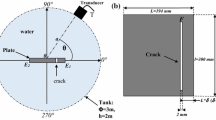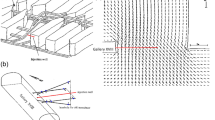Abstract
In this paper a radial-basis-function neural network is used to localize acoustic emission events in ship hulls. It is shown that using a tiny network configuration and a small set of robust features, selected automatically by the K-means algorithm from a superset of 90 signal parameters, the location of a single event can be classified efficiently into three typical areas found in ship hulls. In simulation experiments, where a stiffened plate model is partially sunk into the water, the localization rate of acoustic emission events in a noise-free environment is 100% using four sensors and only four features per sensor. In the proposed method, the feature set is adapted and estimated automatically in cases of noisy environments. Robust acoustic emission localization rates, greater than 90%, are achieved using less than ten features per sensor in case of additive white Gaussian noise at 0 dB SNR or more.






Similar content being viewed by others
References
Spanner J (1974) Acoustic emission—techniques and applications. Intex Publication Co, USA
Williams R (1980) Acoustic emission. A. Hilger, Bristol
Strathaus R, Bea R (1992) Fatigue database development and analysis. Technical Report SMP 1-1, Department of Naval Architecture and Offshore Engineering, University of California at Berkeley
Sucharski D (1995) Crude oil tanker hull structure fracturing: an operator’s perspective. In: Proceedings of the prevention of fracture in ship structure, Washington, DC, pp 87–124
Lotsberg I, Landet E (2005) Fatigue capacity of side longitudinals in floating structures. Mar Struct 18:24–25
Soares G, Garbatov Y (1996) Fatigue reliability of the ship hull girder accounting for inspection and repair. Reliab Eng Syst Saf 51:341–351
Zubaydi A, Haddara M, Swamidas A (2000) On the use of the autocorrelation function to identify the damage in the side of a ship’s hull. Mar Struct 13:537–551
Zubaydi A, Haddara M, Swamidas A (2002) Damage identification in a ship’s structure using neural networks. Ocean Eng 29:1187–1200
Kappatos V, Dermatas E (2007) Feature extraction for crack detection in raining conditions. J Nondestr Eval 26:57–70
Haykin S (1994) Neural networks: a comprehensive foundation. IEEE Press, USA
Nielsen A (1980) Acoustic emission source based on pencil lead breaking. The Danish Welding Institute Publication 80, Copenhagen
Kappatos V, Dermatas E (2005) Classification of acoustic emission and drop signals using SVM, MLP and RBF networks. In: Proceedings of the 5th national NDT conference of the Hellenic Society of Non-Destructive Testing
Author information
Authors and Affiliations
Corresponding author
About this article
Cite this article
Kappatos, V., Dermatas, E. Neural localization of acoustic emission sources in ship hulls. J Mar Sci Technol 14, 248–255 (2009). https://doi.org/10.1007/s00773-009-0051-8
Received:
Accepted:
Published:
Issue Date:
DOI: https://doi.org/10.1007/s00773-009-0051-8




